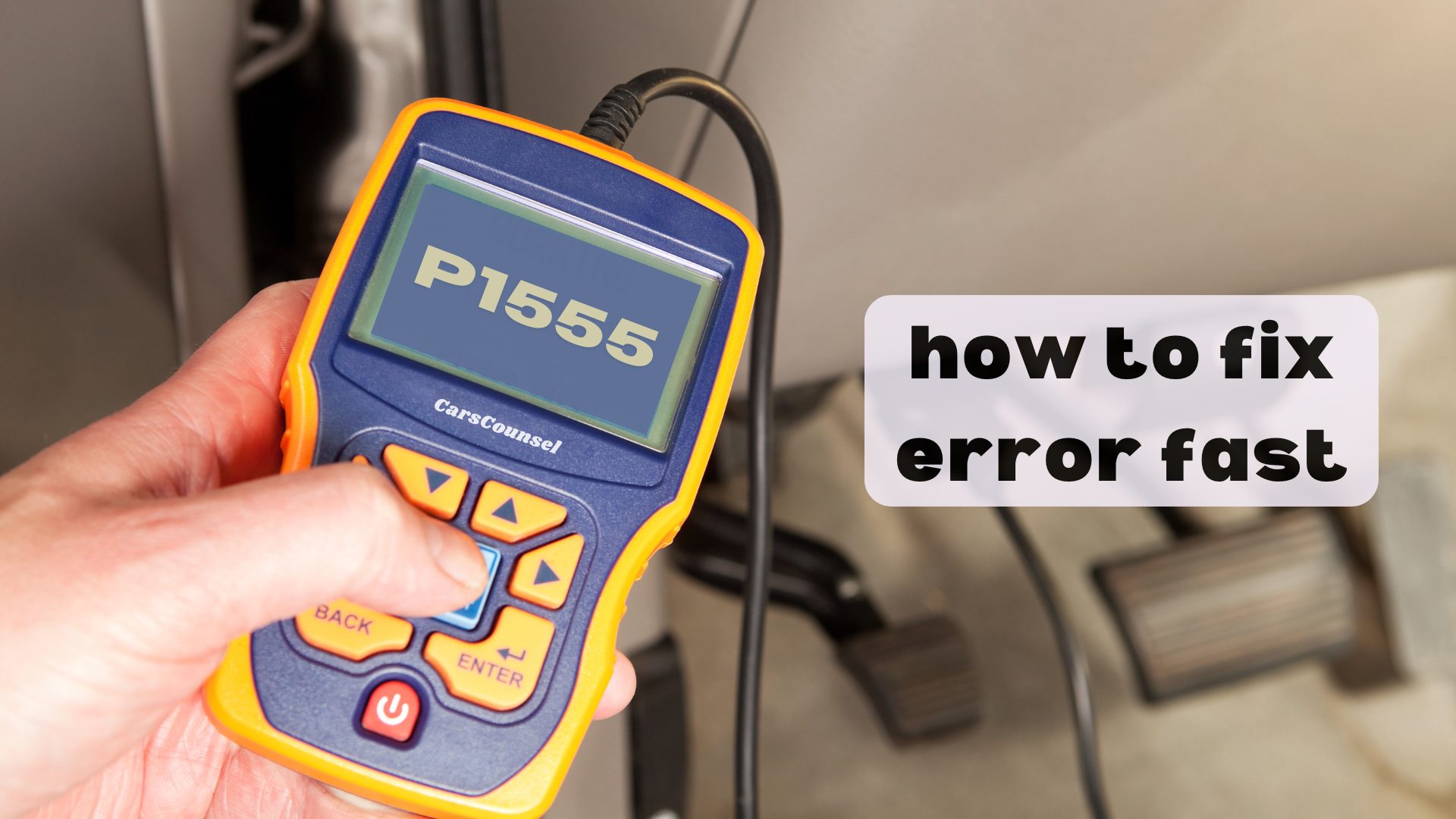When your vehicle’s onboard computer spits out the P1555 code, you know you’ve got a problem on your hands. The electronic variable orifice output is malfunctioning, and that can lead to some serious performance issues. You might notice decreased engine power, strange noises, or even leaks under the hood. But what’s really going on? Is it a faulty sensor, a wiring issue, or something more complex?
To get to the bottom of it, you’ll need to dig deeper and examine the possible causes, symptoms, and repair options. Can you afford to let this problem linger, or is it time to take action and investigate further?

Quick Navigation
Key Takeaways
- The P1555 code indicates a problem with the electronic control system that manages the variable orifice in a vehicle.
- Malfunctioning components, wiring issues, and faulty sensors are common causes of the P1555 code.
- Symptoms of a faulty variable orifice include decreased system performance, unusual sounds or smells, and visible signs of leakage.
- A systematic approach with a scan tool, vehicle history review, and data analysis is necessary to diagnose the root cause of the issue.
- Repairing or replacing faulty parts requires a professional mechanic with advanced diagnostic tools and access to factory service manuals.
Code P1555 Description and Meaning
The P1555 code refers to a specific issue within your vehicle’s system, specifically related to the electronic variable orifice output.
This code indicates a problem with the electronic control system that manages the variable orifice, which regulates the flow of fluids or gases in various systems such as fuel, emissions control, or hydraulic systems.
The code can be found in various vehicle makes and models, and understanding its meaning is vital in determining the root cause of the issue.
Reviewing your vehicle history can provide valuable insights into the electronic details of your car, helping you identify potential problems.
Common Causes of the Error Code
Five common culprits behind the P1555 code are malfunctioning components, each playing a crucial role in the electronic variable orifice system.
As you investigate the issue, you’ll want to focus on vehicle electronics that might be causing the problem. A malfunctioning electronic control unit (ECU) is a prime suspect, as it’s responsible for managing the variable orifice.
Wiring issues or loose connections can also trigger the code, so inspect these areas carefully. Faulty sensors and mechanical problems with the variable orifice itself are other potential causes.
Symptoms of a Faulty Variable Orifice
When your vehicle’s electronic variable orifice malfunctions, you’ll likely notice some telltale symptoms.
The faulty orifice can cause issues with the flow of fluids or gases in your vehicle, leading to problems like fluid leaks, which can result in damage to surrounding components.
You may also hear unusual orifice noise, indicating that the orifice isn’t functioning correctly.
- Decreased system performance: A malfunctioning orifice can reduce the efficiency of the system it’s part of, leading to decreased fuel efficiency, loss of power, or engine stalling.
- Unusual sounds or smells: You may notice unusual sounds, such as hissing or gurgling, or smells, like fuel or coolant, coming from the affected system.
- Visible signs of leakage: Look for signs of fluid leaks around the orifice or related components, which can indicate a faulty orifice.
Diagnosing the P1555 Trouble Code
Diagnosing the P1555 trouble code requires a systematic approach to identify the root cause of the issue.
You’ll need to use a scan tool to retrieve the trouble code and gain access to additional information, such as freeze frame data and live sensor readings.
Reviewing your vehicle’s history can also provide valuable insights, as it may reveal previous issues or repairs related to the electronic variable orifice.
By analyzing this data, you can narrow down the possible causes of the problem and create a plan of attack for further diagnosis.
Be methodical in your approach, and don’t skip over any potential causes, no matter how minor they may seem.
Inspecting the Electronic Control System
With the trouble code retrieved and additional information gathered, you can now shift your focus to inspecting the electronic control system.
This involves performing system checks to identify any issues with the electronic control unit (ECU), wiring, or sensors.
Reviewing wiring diagrams can help you understand the circuitry and pinpoint potential problems.
- Check the ECU for any signs of physical damage or corrosion.
- Inspect the wiring and connections for any signs of wear, corrosion, or damage.
- Verify that all sensors and components are properly connected and functioning correctly.
Testing Sensors and Components
Test the sensors and components involved in the electronic variable orifice system to identify any faulty or malfunctioning parts.
You’ll want to perform a thorough sensor calibration to guarantee accurate readings. Using a circuit analysis tool, inspect the wiring and connections related to the sensors and components for any signs of damage, corrosion, or wear.
Check the sensor outputs and compare them to the manufacturer’s specifications. If you find any discrepancies, it may indicate a faulty sensor or component.
Additionally, perform a visual inspection of the sensors and components for any signs of physical damage or malfunction. By doing so, you’ll be able to pinpoint the root cause of the P1555 code and take the necessary steps to repair or replace the faulty parts.
Repairing or Replacing Faulty Parts
Replace faulty parts with new ones or repair them if possible, taking care to guarantee the new components meet the manufacturer’s specifications.
When developing a replacement strategy, it’s essential to identify the faulty component and assess whether it can be repaired or needs to be replaced entirely.
Three vital steps to follow:
- Verify the faulty component: Confirm you’ve correctly diagnosed the issue and identified the faulty part.
- Choose the correct replacement: Select a replacement part that meets the manufacturer’s specifications to guarantee peak performance.
- Perform the replacement correctly: Follow proper installation procedures to avoid introducing new problems into the system.
Cost to Fix the P1555 Error Code
You’ve identified the faulty component and are ready to tackle the repair.
Now, it’s essential to understand the cost to fix the P1555 error code. Repair estimates can vary widely, depending on the specific cause of the issue and the extent of the repairs needed.
Diagnostic challenges can also impact the cost, as identifying the root cause may require additional time and resources.
On average, the cost of parts and labor for this repair can range from $200 to $500. However, prices can vary significantly based on factors such as vehicle make and model, location, and engine type.
It’s vital to get an accurate estimate from a qualified mechanic to guarantee you’re prepared for the repair costs.
Factors Affecting Repair Costs and Time
Several factors can influence the overall cost and time required to fix the P1555 error code, making it essential to weigh these variables when planning your repair.
You’ll need to ponder labor costs, which can vary depending on the shop’s rates and the mechanic’s expertise.
Regional variations also play a role, as repair shops in urban areas may charge more than those in rural areas.
Additionally, the complexity of the repair and the availability of replacement parts can impact the overall cost and time required.
- Labor costs: The hourly rate of the mechanic and the time required to complete the repair can significantly impact the overall cost.
- Regional variations: Repair shops in different regions may have varying labor rates, overhead costs, and access to parts, affecting the final bill.
- Part availability: The cost and availability of replacement parts, such as sensors or wiring harnesses, can influence the repair time and cost.
Professional Diagnosis and Repair
When dealing with a complex issue like the P1555 code, it’s essential to seek the expertise of a professional mechanic who can provide an accurate diagnosis and efficient repair.
They’ll use advanced diagnostic tools to retrieve trouble codes, inspect wiring and connections, and test sensors involved in the system. With expert advice, you’ll get a precise diagnosis, saving you time and money.
A professional mechanic will also have access to factory service manuals, ensuring the repair is done correctly. Don’t risk misdiagnosis or incorrect repairs that can lead to further damage.
Leave it to the pros to get your vehicle back on the road quickly and safely.
More OBD-II Codes
Frequently Asked Questions
Can I Drive My Vehicle With a P1555 Code?
You should avoid driving your vehicle if you’re experiencing symptoms like misfires, loss of power, or stalling, as it can cause further damage and safety risks, but if the issue is minor, you may be able to drive cautiously while seeking prompt repairs.
Will a P1555 Code Clear Itself Over Time?
You’re wondering if a code will clear itself over time, but unfortunately, it’s unlikely to resolve on its own, as the underlying issue affecting your vehicle’s performance will persist, impacting code duration and overall driving experience.
Can a Faulty Oxygen Sensor Cause a P1555 Code?
Like a detective tracing clues, you’re on the hunt for answers. To your question, yes, a faulty oxygen sensor can trigger a P1555 code, as sensor malfunction can disrupt the electronic variable orifice output, making oxygen sensor replacement a potential solution.
Is It Possible to Repair a P1555 Code Without Replacing Parts?
You can potentially repair a P1555 code without replacing parts by recalibrating sensors, inspecting wiring for corrosion or damage, and ensuring proper connections, but if the issue persists, replacement of faulty components may still be necessary.
Will a P1555 Code Cause Long-Term Engine Damage?
“A stitch in time saves nine” – procrastination can lead to costly repairs. If you don’t address the issue, you’ll likely experience decreased fuel efficiency and compromised engine performance, potentially leading to long-term engine damage and more expensive fixes down the road.
Conclusion
Fixing the P1555 code fixates on ferreting out faulty components, frayed wiring, and faltering sensors. Following a systematic approach, you’ve scrutinized the electronic control system, scrutinized sensor signals, and swapped out suspect parts. With precision and patience, you’ve pinpointed the problem, purified the performance, and propelled your vehicle back to peak power. Now, get back on the road, relieved that your ride is running right.

